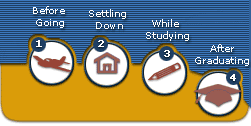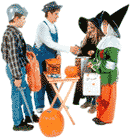 |
 |
 |
 |
 |
 |
 |
| Privacy Policy |
| Disclaimer |
| Terms & Conditions |
|
Talk the Talk: English Speech Is Within Your Reach
This Week: Halloween
Whether or not you participate in the Halloween festivities in your neighborhood, you will see the decorations all around. People put up pictures of all kinds of scary, spooky, and ghastly images on their dorm room doors, homes, and shop windows. Many houses will have Jack-O'-Lanterns sitting out front, glowing dimly for the entertainment of visitors. Pictures of ghosts saying "Boo," witches flying on broomsticks, and goblins gathered in groups appear all around. Monsters of every shape and variety haunt the doorways and hallways everywhere. Why do people decorate this way, you ask? For the children who enjoy the holiday. On Halloween, children dress up in costumes and go to their neighbors' homes saying "trick-or-treat" when people answer the door. Generally, people open their doors only if they have treats (small candy bars and such things) to give to the children. Another thing that many people do on Halloween is watch scary movies. Often these are B-movies or slasher flicks that tell tales of such things as ghosts, poltergeists, murderous toys, and insane killers. Different cultures and religions have various ways of recognizing this time of year. Halloween has its roots in the Irish festival of Samhein, celebrating the end of summer. In Scotland, Halloween took its name from All Hallows' Eve, the night before All Saints' Day. Mexicans celebrate Dia de Muertos (Day of the Dead) for a couple of days after Halloween.
Definitions All Hallows' Eve: It was once believed that on October 31st the souls of the dead would wander the Earth looking for people to possess. The next day they would all rest, as the saints' lives were celebrated (on All Saints' Day). Thus the evening before was known as All Hallows' Eve, which later was shortened to Halloween. ("Eve" is short for "evening".) All Saints' Day: The day after Halloween used to be set aside for celebrating the saints' lives. Because the day was not dedicated to one saint, it was known as All Saints' Day. B-Movie: A low-budget film. In the golden era of film-making there were two kinds of movies: A-movies and B-movies. When people went to the theater, they went to see two films, one of each type. A-movies had the big stars and big budgets, while B-movies had little-known (at the time) stars and smaller budgets. Today we use the term B-movie to describe any film that seems second rate. Many horror films are considered B-movies. A "slasher flick" is simply a B-movie about an insane killer. Boo: An interjection intended to surprise or scare other people. On Halloween, when children come to people's doors trick-or-treating, they sometimes open the door and say "Boo!" to scare the children. Dia de Muertos: The Mexican "Day of the Dead" is actually two days: November first and second. On the first day of November, Mexicans remember children who have died; on the second day of November, they remember those people who have died as adults. Stores throughout Mexico decorate their windows for about two weeks leading up to Dia de Muertos. They put up (and many sell) small dolls in the shape of skeletons, sometimes dressed up to represent office workers, students, and other kinds of people. Ghastly: Horrible or unpleasant. Something that looks ghastly is ugly or repulsive. Ghosts: The spirits of the dead. Ghosts are said to come back from the dead, sometimes to haunt the living, sometimes to wander about. Different cultures have different kinds of stories about ghosts; some believe that ghosts are evil, and others believe that ghosts are good. Goblins: Small, ugly creatures, usually green, that are part of the Halloween myth (among others). These monsters are often pictured on Halloween decorations. Halloween: All Hallow's Evening. Some people believed that on the night of October 31st all of the spirits of the dead would walk the earth. Some believed that forest spirits would pretend to be hungry humans and go from door to door asking for food. Those who gave food were treated favorably through the next year; those who turned the spirits away without giving food had pranks played upon them through the next year. Today, this is a celebration in which children (and some adults) dress up in costumes. Children go from door to door asking for candy. Adults, often, have costume parties. Haunt: To inhabit. In the context of Halloween this suggests that ghosts, poltergeists, or other supernatural beings reside in some place. (Such as a "haunted house" - a house with a ghost or ghosts in it.) Jack-O'-Lanterns: Pumpkins that have been hollowed out and had faces carved into them. The story is that a man named Jack made a deal with the Devil, but he tricked the Devil, and caught him in a tree. People used to carve Jack-O'-Lanterns to scare away the Devil on Halloween. Monsters: Any creature (usually fantastic) that doesn't look natural. Frankenstein, Godzilla, and vampires are all examples of famous monsters from literature and film. Poltergeist: A type of ghost that is usually noisy and evil. Some superstitious people blame noises, broken dishes, and such things on poltergeists. Steven Spielberg created a series of films with the name Poltergeist. Samhein: The ancient Irish celebration of the end of summer (known to ancient Celts as Samhain). Ancient Celts ritually slaughtered weak animals in order to symbolize the elminiation of weakness within their community. Scary: Frightening or alarming. Spooky: Suggestive of ghosts or other supernatural beings (or "spooks"). Frightening. Trick-or-treat: A Halloween tradition in which children dress up in costumes and go from door to door saying the phrase "trick-or-treat," meaning they would like some candy (treats) or they may play some sort of prank (trick) upon the homeowner or occupant. Witch: A woman - usually depicted as ugly and warty, wearing a pointy black hat, and riding on a flying broom - who has magical powers. Some people believe that witches and wizards, the male counterparts of witches, get their power from the Devil.
Do you still have unanswered questions about this topic -- or about anything else? Is there something that you would like to see an article about? Do you have advice, ideas, or experiences you would like to share with other international students? Let us know -- send us a message at: CityHall@istudentcity.com |
 |
| ||||||||||||||||||||||||||||||
|
| ||||||||||||||||||||||||||||||
|
|
Slang Channel Yes, the English language can be confusing, but don't let that stop you from having fun. Join the "Slang Channel!" |
Home | About iStudentCity | Job Opportunities | Contact iStudentCity Hall
Copyright©2000-2009, iStudentCity.com. All Rights Reserved.
 At the end of October, many Americans, mostly children, participate in
At the end of October, many Americans, mostly children, participate in
